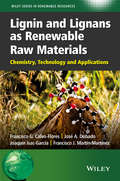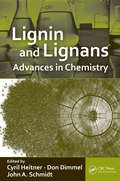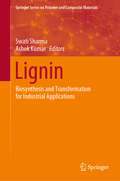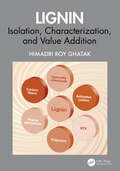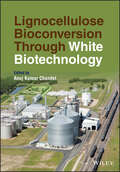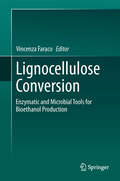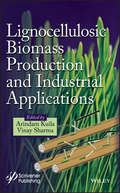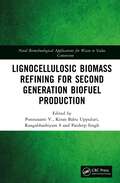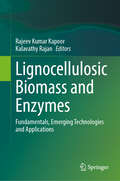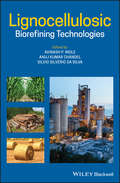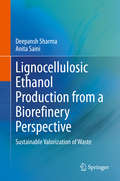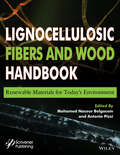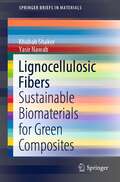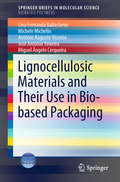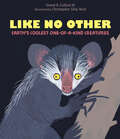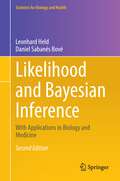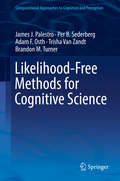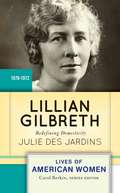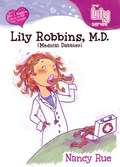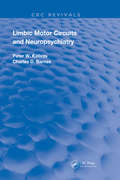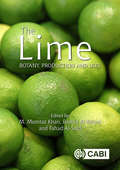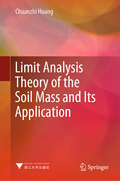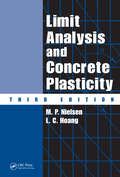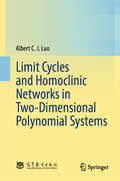- Table View
- List View
Lignin and Lignans as Renewable Raw Materials
by Francisco G. Calvo-Flores Joaquín Isac-García José A. Dobado Francisco J. Martín-MartínezAs naturally occurring and abundant sources of non-fossil carbon, lignin and lignans offer exciting possibilities as a source of commercially valuable products, moving away from petrochemical-based feedstocks in favour of renewable raw materials. Lignin can be used directly in fields such as agriculture, livestock, soil rehabilitation, bioremediation and the polymer industry, or it can be chemically modified for the fabrication of specialty and high-value chemicals such as resins, adhesives, fuels and greases. Lignin and Lignans as Renewable Raw Materials presents a multidisciplinary overview of the state-of-the-art and future prospects of lignin and lignans. The book discusses the origin, structure, function and applications of both types of compounds, describing the main resources and values of these products as carbon raw materials. Topics covered include: * Structure and physicochemical properties* Lignin detection methods* Biosynthesis of lignin* Isolation methods* Characterization and modification of lignins* Applications of modified and unmodified lignins * Lignans: structure, chemical and biological properties* Future perspectives This book is a comprehensive resource for researchers, scientists and engineers in academia and industry working on new possibilities for the application of renewable raw materials. For more information on the Wiley Series in Renewable Resources, visit www.wiley.com/go/rrs
Lignin and Lignans: Advances in Chemistry
by Cyril Heitner Donald R. Dimmel John A. SchmidtOver the past four decades, there has been immense progress in every area of lignin science, ranging from the enzymology of lignin biodegradation, to the delignification of wood fiber during pulping and bleaching, to advances in spectroscopy. Lignin and Lignans: Advances in Chemistry captures the developments that have been achieved by world-class
Lignin: Biosynthesis and Transformation for Industrial Applications (Springer Series on Polymer and Composite Materials)
by Ashok Kumar Swati SharmaThis book presents a comprehensive overview on origin, structure, properties, modification strategies and applications of the biopolymer lignin. It is organized into four themed parts. The first part focuses on the analysis and characterization of the second most abundant biopolymer. The following part is devoted to the biological aspects of lignin such as biosynthesis and degradation. In the third part, chemical modification strategies and the preparation of composites as well as nano- and microparticles are discussed.The final part addresses the industrial application of lignin and its derivatives, as well as lignin materials. The usage for synthesis of biofuels, fine chemicals and in agriculture and food industry is covered.This book is a comprehensive source for researchers, scientists and engineers working in the field of biopolymers as well as renewable materials and sources.
Lignin: Isolation, Characterization, and Value Addition
by Himadri Roy GhatakThis book covers the current know-how on lignin, its sustainable isolation from lignocellulose, characterization of the isolated lignin, and transforming it to add value. The book is divided into three sections. A section on lignin isolation elaborates the well-established commercial delignification methods, including recent developments. The lignin characterization section includes traditional methods based on wet chemistry and advanced characterization techniques. It covers lignin value addition with the possibility of transforming lignin into functional materials, backed by figures and graphical presentations.Features: Provides exclusive information on lignin isolation, including conventional processes as well as recent advances, Covers reaction mechanisms, kinetics, mass transfer, and unit operations, including all aspects of laboratory-based lignin characterization, Focuses on lignin as a starting material for obtaining functional materials, Discusses the current state of advancement of lignin value addition. This book is aimed at researchers, professionals, and graduate students in chemical engineering and industrial chemistry.
Lignocellulose Bioconversion Through White Biotechnology
by Anuj Kumar ChandelLignocellulose Bioconversion Through White Biotechnology Comprehensive resource summarizing the recent technological advancements in white biotechnology and biomass conversion into fuels, chemicals, food, and more Lignocellulose Bioconversion Through White Biotechnology presents cutting-edge information on lignocellulose biomass conversion, detailing how white biotechnology can develop sustainable biomass pretreatment methods, effective plant cell wall degrading enzymes to yield high quality cellulosic sugars, and the eventual conversion of these sugars into fuels, chemicals, and other materials. To provide comprehensive coverage of the subject, the work offers in-depth critical analysis into both techno-economic and life cycle analysis of lignocellulose-based products. Each of the 16 chapters, written by a well-qualified and established researchers, academics, or engineers, presents key information on a specific facet of lignocellulose-based products. Topics covered include: Lignocellulose feedstock availability, types of feedstock, and potential crops that are of high interest to the industry Lignocellulose bioconversion, including both foundational technical aspects and new modern developments Plant cell wall degrading enzymes, including cellulase improvement and production challenges/solutions when scaling up Improvements and challenges when considering fermenting microorganisms for cellulosic sugars utilization Scaling up of lignocellulose conversion, including insight into current challenges and future practices Techno-economic aspects of lignocellulose feedstock conversion, green consumerism and industrialization aspects of renewable fuels/chemicals Students, academics, researchers, bio-business analysts, and policy-makers working on sustainable fuels, chemicals, materials, and renewable fuels can use Lignocellulose Bioconversion Through White Biotechnology to gain invaluable expert insight into the subject, its current state of the art, and potential exciting future avenues to explore.
Lignocellulose Conversion
by Vincenza FaracoBioethanol has been recognized as a potential alternative to petroleum-derived transportation fuels. Even if cellulosic biomass is less expensive than corn and sugarcane, the higher costs for its conversion make the near-term price of cellulosic ethanol higher than that of corn ethanol and even more than that of sugarcane ethanol. Conventional process for bioethanol production from lignocellulose includes a chemical/physical pre-treatment of lignocellulose for lignin removal, mostly based on auto hydrolysis and acid hydrolysis, followed by saccharification of the free accessible cellulose portions of the biomass. The highest yields of fermentable sugars from cellulose portion are achieved by means of enzymatic hydrolysis, currently carried out using a mix of cellulases from the fungus Trichoderma reesei. Reduction of (hemi)cellulases production costs is strongly required to increase competitiveness of second generation bioethanol production. The final step is the fermentation of sugars obtained from saccharification, typically performed by the yeast Saccharomyces cerevisiae. The current process is optimized for 6-carbon sugars fermentation, since most of yeasts cannot ferment 5-carbon sugars. Thus, research is aimed at exploring new engineered yeasts abilities to co-ferment 5- and 6-carbon sugars. Among the main routes to advance cellulosic ethanol, consolidate bio-processing, namely direct conversion of biomass into ethanol by a genetically modified microbes, holds tremendous potential to reduce ethanol production costs. Finally, the use of all the components of lignocellulose to produce a large spectra of biobased products is another challenge for further improving competitiveness of second generation bioethanol production, developing a biorefinery.
Lignocellulosic Biomass Production and Industrial Applications
by Arindam Kuila Vinay SharmaLignocellulosic Biomass Production and Industrial Applications describes the utilization of lignocellulosic biomass for various applications. Although there have been numerous reports on lignocellulosic biomass for biofuel application, there have been very few other applications reported for lignocellulosic biomass-based chemicals and polymers. Therefore, this book covers all of the possible lignocellulosic biomass applications. Besides describing the different types of biofuel production, such as bioethanol, biobutanol, biodiesel and biogas from lignocellulosic biomass, it also presents various other lignocellulosic biomass biorefinery applications for the production of chemicals, polymers, paper and bioplastics. In addition, there are chapters on valorization of lignocellulosic materials, alkali treatment to improve the physical, mechanical and chemical properties of lignocellulosic natural fibers, and a discussion of the major benefits, limitations and future prospects of the use of lignocellulosic biomass.
Lignocellulosic Biomass Refining for Second Generation Biofuel Production (Novel Biotechnological Applications for Waste to Value Conversion)
by Ponnusami V.This book compiles research aspects of second generation (2G) biofuel production specifically sourced from lignocellulose biomass with the direction of biorefinery means. It focusses on the valorization of different sources of 2G biofuels and their relative importance. The constituents of lignocelluloses and their potential characteristics, end utilization of biofuel from production are discussed. Different means of treatments of lignocellulose through physical, physio-chemical, microbial, and enzymatic approaches are also included. Features: Describes technological advancements for bioethanol production from lignocellulosic waste. Provides the roadmap for the production and utilization of 2G Biofuels. Introduces the strategic role of metabolic engineering in the development of 2G biofuels. Discusses technological advancements, life cycle assessment, and prospects. Explores the novel potential lignocellulosic biomass for 2G biofuels. This book is aimed at researchers and professionals in renewable energy, biofuel, bioethanol, lignocellulose conversion, fermentation, and chemical engineering.
Lignocellulosic Biomass and Enzymes: Fundamentals, Emerging Technologies and Applications
by Rajeev Kumar Kapoor Kalavathy RajanThis book aims to offer comprehensive insights into biomass pretreatment and utilization for recovering value-added products. The book focuses on various topics including lignocellulosic biorefinery challenges, lignolytic enzymes, bioprocess advancements, and emerging industrial applications. It also serves as a knowledge repository on the use of lignocellulosic biomass and enzymes in biotechnological processes, bio-composites development, pulp and paper processing, bio-energy production, biomass detoxification, and more. Chapters of this book cover a broad focus on enzyme technologies, treatment strategies, and the application of industrially important enzymes. Chapters cover the unique features, like the focus on economically feasible treatment strategies, and highlight the book's emphasis on practicality. The book includes aspects of microbial enzymes and biomass overview, advancements in biomass pretreatment, metabolic and genetic engineering approaches, improved process and recovery strategies, eco-friendly bio bleaching in the pulp and paper industry, bioethanol production, and lignocellulose biorefinery. This book is targeted towards a diverse audience including undergraduates, postgraduates, and researchers in academia and industries.
Lignocellulosic Biorefining Technologies
by Anuj Kumar Chandel Avinash P. Ingle Silvio Silv?rio da SilvaA text to the advances and development of novel technologies in the production of high-value products from economically viable raw materials Lignocellulosic Biorefining Technologiesis an essential guide to the most recent advances and developments of novel technologies in the production of various high-value products from economically viable raw materials. Written by a team of experts on the topic, the book covers important topics specifically on production of economical and sustainable products such as various biofuels, organic acids, enzymes, biopigments, biosurfactants, etc. The book highlights the important aspects of lignocellulosic biorefining including structure, function, and chemical composition of the plant cell wall and reviews the details about the various components present in the lignocellulosic biomass and their characterizations. The authors explore the various approaches available for processing lignocellulosic biomass into second generation sugars and focus on the possibilities of utilization of lignocellulosic feedstocks for the production of biofuels and biochemicals. Each chapter includes a range of clear, informative tables and figures, and contains relevant references of published articles. This important text: Provides cutting-edge information on the recent developments in lignocellulose biorefinery Reviews production of various economically important and sustainable products, such as biofuels, organic acids, biopigments, and biosurfactants Highlights several broad-ranging areas of recent advances in the utilization of a variety of lignocellulosic feedstocks Provides a valuable, authoritative reference for anyone interested in the topic Written for post-graduate students and researchers in disciplines such as biotechnology, bioengineering, forestry, agriculture, and chemical industry, Lignocellulosic Biorefining Technologies is an authoritative and updated guide to the knowledge about various biorefining technologies.
Lignocellulosic Ethanol Production from a Biorefinery Perspective: Sustainable Valorization of Waste
by Deepansh Sharma Anita SainiThis book provides an overview of the multi-dimensional approach for the production of ethanol from lignocellulosic biomass. The sustainability of this biofuel, the current and future status of the technology and its role in waste valorization are also addressed.Bioethanol from lignocellulosic material has emerged as an alternative to the traditional first-generation bioethanol. The book also discusses various pretreatment methods for effective separation of the various components of lignocellulosic feedstock as well as their advantages, and limitations. It describes the valorization of lignocellulosic waste through the production of bioethanol and emphasizes the significance of waste utilization in managing the production cost of the fuel. Finally, the utilization of genetically engineered plants and microorganisms to increase the conversion efficiency is reviewed.
Lignocellulosic Fibers and Wood Handbook: Renewable Materials for Today's Environment
by Naceur Belgacem Antonio PizziThis book will focus on lignocellulosic fibres as a raw material for several applications. It will start with wood chemistry and morphology. Then, some fibre isolation processes will be given, before moving to composites, panel and paper manufacturing, characterization and aging.
Lignocellulosic Fibers: Sustainable Biomaterials for Green Composites (SpringerBriefs in Materials)
by Yasir Nawab Khubab ShakerThe book is primarily focused on natural plant (lignocellulosic) fibers as sustainable reinforcement material for green composites. It begins with a brief introduction to common plant-based reinforcements, their extraction techniques, the structure of plant fibers, and describes novel fibers extracted from fruit, seeds, leaf, bast, and agricultural waste. The book then focuses on the application of these fibers as reinforcements for composite materials, covering reinforcement and composite fabrication techniques, as well as their performance evaluation. Overall, the book provides a unique and comprehensive look at lignocellulosic fibers for use in green composites, appealing to both researchers in the area of sustainable materials and industry professionals and entrepreneurs interested in their utilization in value-added composite products.
Lignocellulosic Materials and Their Use in Bio-based Packaging (SpringerBriefs in Molecular Science)
by Lina Fernanda Ballesteros Michele Michelin António Augusto Vicente José António Teixeira Miguel Ângelo CerqueiraThis brief provides a comprehensive review of lignocellulosic materials and their primary role in the future development of bio-based packaging. Topics such as: sources and extraction methods of lignocellulosic materials; main constituents of lignocellulosic materials; functionality of lignocellulosic materials; the development of bio-based and biodegradable packaging; incorporation of lignocellulosic materials in bio-based packaging materials; properties and functionality of bio-based packaging, are discussed by authors who are experts in the field.
Like No Other: Earth’s Coolest One-of-a-Kind Creatures
by Sneed B. CollardThis fascinating look at thirteen unusual animals, many of them rare or endangered, introduces the remarkable world of monotypic animals—those without any close relatives.One-of-a-kind animals can be as familiar as the platypus or as unfamiliar as the purple frog. These fascinating and mysterious species belong to an exclusive club of living things: those with no close living relatives, making them monotypic species. Meet more than a dozen of these creatures (including humans!), learn what makes them unique, and explore the relationships among species on the evolutionary tree. Written by NCTE Orbis Pictus award-winning author Sneed B. Collard III, this fascinating nonfiction picture book is ideal for kids, teachers, and librarians and includes extensive back matter and activities.
Like a Virgin: How Science is Redesigning the Rules of Sex
by Aarathi PrasadMost cultures tell the tale of a maiden who gives birth untouched by a man. Is this just a myth, or could virgin birth become the way we make babies in the future? In Like a Virgin, biologist Aarathi Prasad explores inconceivable ideas about conception, from the "Jesus Christ" lizard's ability to self-reproduce (it walks on water, too) to the hunt for a real-life virgin mother among geneticists in the 1950s. Prasad then transports us to the maverick laboratories that today are inventing the equivalent of "non-sexual selection", from egg-fertilizing computer chips to artificial wombs for men. This adventurous romp to the frontiers of reproductive science will forever change the way you think about sex and parenthood. Aarathi Prasad is a biologist and science writer. She has appeared on television and radio, including as host of the BBC documentary "The Quest for a Virgin Birth," and written for publications such as Wired, New Scientist, and The Guardian. A single mother, she previously worked in research genetics at Imperial College, London. This is her first book.
Likelihood and Bayesian Inference: With Applications in Biology and Medicine (Statistics for Biology and Health)
by Leonhard Held Daniel Sabanés BovéThis richly illustrated textbook covers modern statistical methods with applications in medicine, epidemiology and biology. Firstly, it discusses the importance of statistical models in applied quantitative research and the central role of the likelihood function, describing likelihood-based inference from a frequentist viewpoint, and exploring the properties of the maximum likelihood estimate, the score function, the likelihood ratio and the Wald statistic. In the second part of the book, likelihood is combined with prior information to perform Bayesian inference. Topics include Bayesian updating, conjugate and reference priors, Bayesian point and interval estimates, Bayesian asymptotics and empirical Bayes methods. It includes a separate chapter on modern numerical techniques for Bayesian inference, and also addresses advanced topics, such as model choice and prediction from frequentist and Bayesian perspectives. This revised edition of the book “Applied Statistical Inference” has been expanded to include new material on Markov models for time series analysis. It also features a comprehensive appendix covering the prerequisites in probability theory, matrix algebra, mathematical calculus, and numerical analysis, and each chapter is complemented by exercises. The text is primarily intended for graduate statistics and biostatistics students with an interest in applications.
Likelihood-Free Methods for Cognitive Science (Computational Approaches to Cognition and Perception)
by James J. Palestro Per B. Sederberg Adam F. Osth Trisha Zandt Brandon M. TurnerThis book explains the foundation of approximate Bayesian computation (ABC), an approach to Bayesian inference that does not require the specification of a likelihood function. As a result, ABC can be used to estimate posterior distributions of parameters for simulation-based models. Simulation-based models are now very popular in cognitive science, as are Bayesian methods for performing parameter inference. As such, the recent developments of likelihood-free techniques are an important advancement for the field. Chapters discuss the philosophy of Bayesian inference as well as provide several algorithms for performing ABC. Chapters also apply some of the algorithms in a tutorial fashion, with one specific application to the Minerva 2 model. In addition, the book discusses several applications of ABC methodology to recent problems in cognitive science. Likelihood-Free Methods for Cognitive Science will be of interest to researchers and graduate students working in experimental, applied, and cognitive science.
Lillian Gilbreth
by Julie Des JardinsLillian Gilbreth is a stunning example of female ingenuity in the early twentieth century. At a time when women were standard fixtures in the home and barely accepted in many professions, Gilbreth excelled in both spheres, concurrently winning honors as "Engineer of the Year” and "Mother of the Year. ” This accessible, engaging introduction to the life of Lillian Gilbreth examines her pivotal role in establishing the discipline of industrial psychology, her work as an engineer of domestic management and home economics, and her role as mother of twelve children--made famous by the book, and later movie, Cheaper by the Dozen. This book examines the life of an exceptional woman who was able to negotiate the divide between the public and domestic spheres and define it on her terms. About the Lives of American Women series: Selected and edited by renowned women’s historian Carol Berkin, these brief biographies are designed for use in undergraduate courses. Rather than a comprehensive approach, each biography focuses instead on a particular aspect of a women’s life that is emblematic of her time, or which made her a pivotal figure in the era. The emphasis is on a "good read,” featuring accessible writing and compelling narratives, without sacrificing sound scholarship and academic integrity. Primary sources at the end of each biography reveal the subject’s perspective in her own words. Study questions and an annotated bibliography support the student reader.
Lily Robbins, M. D.: Medical Dabbler
by Nancy RueAfter witnessing a car accident and helping a little boy who was hurt, Lily is on a mission to become a "great healer" or healthcare professional, and no one's going to stop her. Lily starts watching medical shows on TV and checking out health books at the library, but that's not all, she signs up for a health class for girls at a local health club.
Limbic Motor Circuits and Neuropsychiatry (Routledge Revivals)
by Peter W. Kalivas Charles D. BarnesPublished in 1993. Limbic Motor Circuits and Neuropsychiatry explores the neural circuitry employed by mammals to interpret environmental stimuli that provoke adaptive behavioral responses. Internationally recognized biomedical scientists have contributed chapters that describe and evaluate the anatomy, physiology, pharmacology, and pathophysiology of how motivationally relevant environmental or interoceptive stimuli are translated into adaptive or maladaptive behavioral responses. The book also examines how classic limbic nuclei communicate with classic motor systems and the implications in neuropsychiatric disorders. This reference presents exciting new information that will interest neuroscientists, psychiatrists, neuropsychopharmacologists, and behavioral pharmacologists.
Lime, The: Botany, Production and Uses (Botany, Production and Uses)
by W Ahmed M A Ali G Almaguer-Vargas A M Al-Saidi A Al-Maskary U Ammara C F Aquino N Cruz-Huerta D L Siqueira P Donkersley S L Elliot A A Farooque F García-Sánchez V Gimeno V González-Hernández M A Hanif R Janke M L Keremane A S Khan Y Z Liu B S Marquez J J Martínez-Nicolás A Nasehi M A Nawaz S Padmanabhan R B Queiroz C Ramadugu I Ramírez-Ramírez M F Razi M L Roose L C Salomão A W Schumann R W Scora S Simón-Grao Z Singh A K Srivastava M Usman M Waly Q U ZamanThe lime is an important fruit crop throughout the citrus producing regions of the world, with its own specific benefits and issues affecting successful cultivation and production. Limes: Botany, Production and Uses covers the breeding, genetics and biodiversity of the plants, and explains the processes for establishing a lime orchard, including propagation techniques, pruning and thinning of established trees, water requirements and irrigation systems. All the major problems of lime cultivation are explored and discussed, including increasing threats such as Witches' Broom Disease and Citrus Greening, along with approaches for pest and disease management and prevention.
Limit Analysis Theory of the Soil Mass and Its Application
by Chuanzhi HuangThis book establishes the equations of limit analysis and provides a complete theoretical basis for foundation capacity, slope stability, and earth pressure. It is divided into three parts, the first of which discusses the failure mode and fundamental equation of soil mass. The second part addresses the solution methods for limit analysis, including the characteristic line method, stress field method, limit equilibrium method, virtual work equation-based generalized limit equilibrium method and generalized limit equilibrium method for the surface failure mode. Lastly, the third part examines the application of the limit analysis theory to soil mass.
Limit Analysis and Concrete Plasticity
by M.P. Nielsen L.C. HoangLimit Analysis and Concrete Plasticity, Second Edition explains the basic principles of plasticity theory and its application to the design of reinforced and prestressed concrete structures, providing a thorough understanding of the subject, rather than simply applying current design codes. This understanding enables the design student or engineer to solve problems more effectively and safely. Fully updated, the second edition includes new treatments in a variety of areas and includes numerical methods and computer code for solving problems, incorporating methods into Eurocode 2-the common concrete standard for all of Europe.
Limit Cycles and Homoclinic Networks in Two-Dimensional Polynomial Systems
by Albert C. LuoThis book is a monograph about limit cycles and homoclinic networks in polynomial systems. The study of dynamical behaviors of polynomial dynamical systems was stimulated by Hilbert’s sixteenth problem in 1900. Many scientists have tried to work on Hilbert's sixteenth problem, but no significant results have been achieved yet. In this book, the properties of equilibriums in planar polynomial dynamical systems are studied. The corresponding first integral manifolds are determined. The homoclinic networks of saddles and centers (or limit cycles) in crossing-univariate polynomial systems are discussed, and the corresponding bifurcation theory is developed. The corresponding first integral manifolds are polynomial functions. The maximum numbers of centers and saddles in homoclinic networks are obtained, and the maximum numbers of sinks, sources, and saddles in homoclinic networks without centers are obtained as well. Such studies are to achieve global dynamics of planar polynomial dynamical systems, which can help one study global behaviors in nonlinear dynamical systems in physics, chemical reaction dynamics, engineering dynamics, and so on. This book is a reference for graduate students and researchers in the field of dynamical systems and control in mathematics, mechanical, and electrical engineering.
